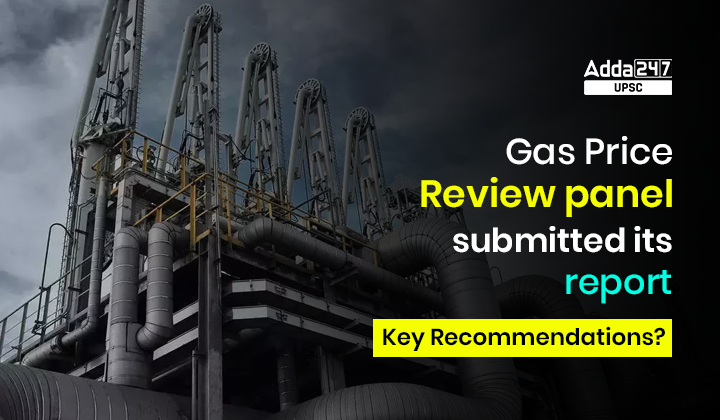Table of Contents
Relevance of Gas Price Review Panel for UPSC
Gas Price Review Panel covers:
GS 2: Government Policies & Interventions.
GS Paper 3: Infrastructure, Mobilization of Resources, Growth & Development, Mineral & Energy Resources, Conservation of Resources.
Also Read:
The Centre Forms Panel to Revamp MNREGA Scheme!
Why Gas Price Review Panel in news?
Gas Price Review Panel/Kirit Parikh panel submitted gas report, suggested pricing freedom beginning Jan. 2026.
Background of Gas Price Review Panel
- Prime Minister Narendra Modi wants to raise the share of gas in India’s energy mix to 15% by 2030 from 6.2%, helping it progress towards meeting a 2070 net zero carbon-emission goal.
- Also, the state-set local gas prices and ceiling rates are at a record high and are expected to rise further due to a surge in global gas prices triggered by the Ukraine-Russia conflict.
- So, in September India set up a panel headed by energy expert Kirit Parikh to review the India’s gas pricing formula to ensure fair prices to consumers after state-set prices of gas from old fields and a ceiling price for output from difficult blocks rose to a record high.
Also Read:
Why India’s Fight Against Inflation Continues? | Today’s the Hindu Editorial Analysis for UPSC
What is current formula to decide Gas Price?
- To incentivise gas producers and boost local output, since 2014 India has linked local gas prices to a formula tied to global benchmarks, including Henry Hub, Alberta gas, NBP and Russian gas.
- In 2016, the country began fixing the ceiling prices of gas produced from ultra-deep water and challenging fields and allowed marketing freedom to the operators of these fields.
What was the task of the Gas Price Review Panel?
- The committee was tasked with suggesting a “fair price to the end-consumer” while ensuring a “market-oriented, transparent and reliable pricing regime for India’s long-term vision for ensuring a gas-based economy.”
- Its mandate was to suggest a regime that would help raise domestic production to help meet the goal of 15% of energy coming from gas by 2030. And at the same time, provide fair price to consumers.
Key Recommendations of Gas Price Review panel
- Gas Price Review panel recommended a floor and ceiling price for legacy fields and complete pricing freedom starting January 1, 2026.
- Gas Price Review panel recommended a fixed band of pricing for gas from legacy fields, which makes up for two-thirds of all natural gas produced in the country, would ensure a predictable pricing regime for producers and at the same time moderate prices of CNG and piped cooking gas which has shot up by 70% since last year on the back of a surge in input cost.
- The panel had suggested linking the price of gas produced by state-owned firms from fields given to them on a nomination basis to imported crude oil prices rather than benchmarking them to gas rates in international markets, adding the rates thus arrived would be subject to a floor and ceiling.
- Kirit Parikh Panel has recommended a floor price of $4 per mmBtu (Metric Million British Thermal Unit) and a cap of $6.5 per mmBtu for legacy and old fields being operated by ONGC and OIL.
- It suggested the ceiling rate for this gas from legacy or old fields, called APM gas, will be increased by $0.5 per mmBtu annually.
To include Natural Gas in the GST Regime
- The panel also suggested including natural gas in the one-nation-one-tax regime of GST by subsuming excise duty charged by the central government and varying rates of VAT levied by state governments.
- To address state concern of loss of revenue, the panel recommended setting up a mechanism similar to the compensation cess regime that made good for any revenue loss that states incurred by way of giving their right to levy VAT and other taxes on goods and services in first five years of implementation of GST regime from July 1, 2017.
- Also, the panel is in favor of moderation in rates of excise duty.
Also Read:
Why India’s Fight Against Inflation Continues? | Today’s the Hindu Editorial Analysis for UPSC
Other Important Articles from Economy Section:
FAQs
Q. Who headed Gas Price Review Panel?
Ans. Gas Price Review panel headed by energy expert Kirit Parikh to review the India’s gas pricing formula.
Q. When did India link local gas prices to a formula tied to global benchmarks?
Ans. To incentivize gas producers and boost local output, since 2014 India has linked local gas prices to a formula tied to global benchmarks, including Henry Hub, Alberta gas, NBP and Russian gas.




 TSPSC Group 1 Question Paper 2024, Downl...
TSPSC Group 1 Question Paper 2024, Downl...
 TSPSC Group 1 Answer key 2024 Out, Downl...
TSPSC Group 1 Answer key 2024 Out, Downl...
 UPSC Prelims 2024 Question Paper, Downlo...
UPSC Prelims 2024 Question Paper, Downlo...





